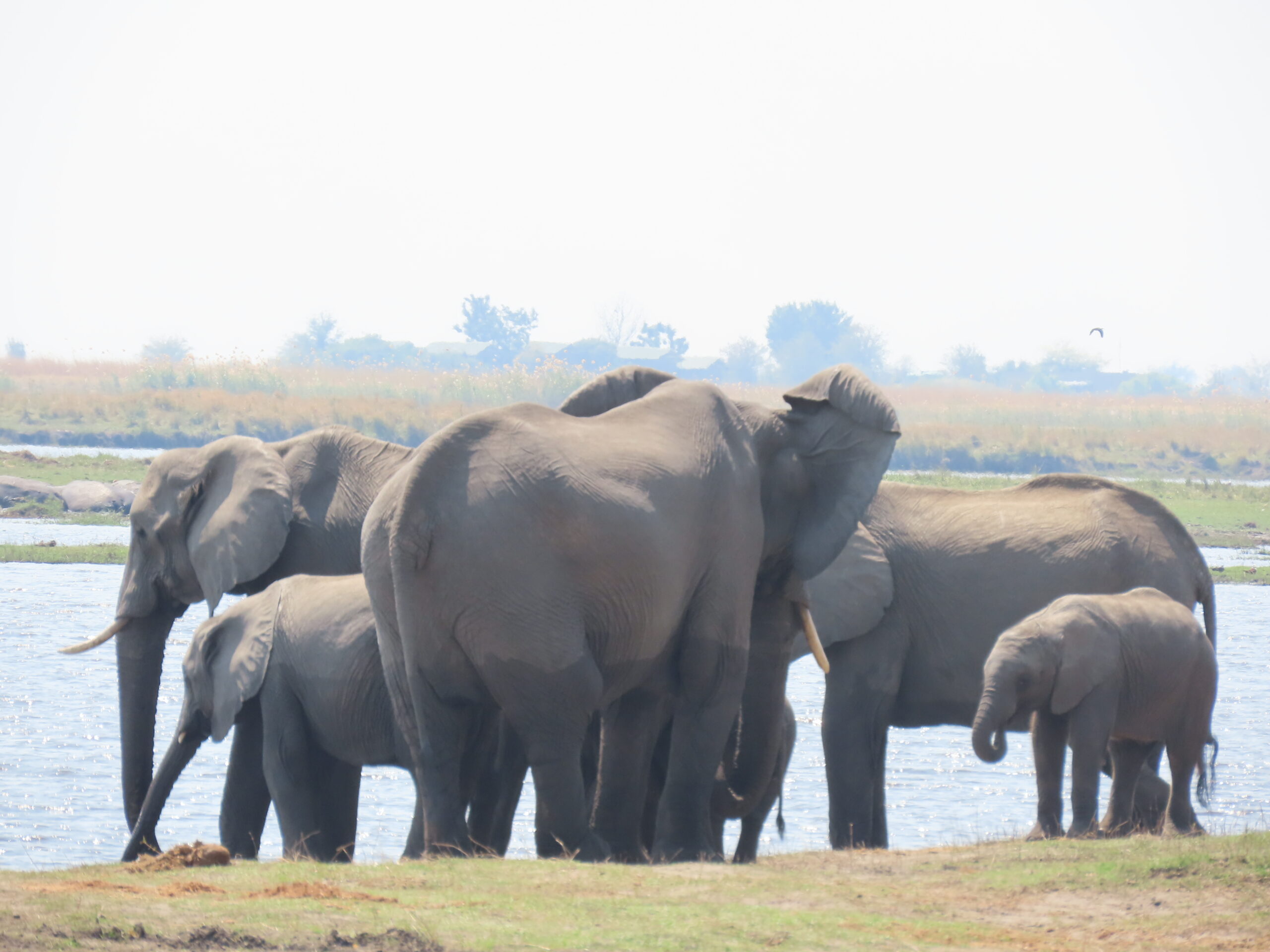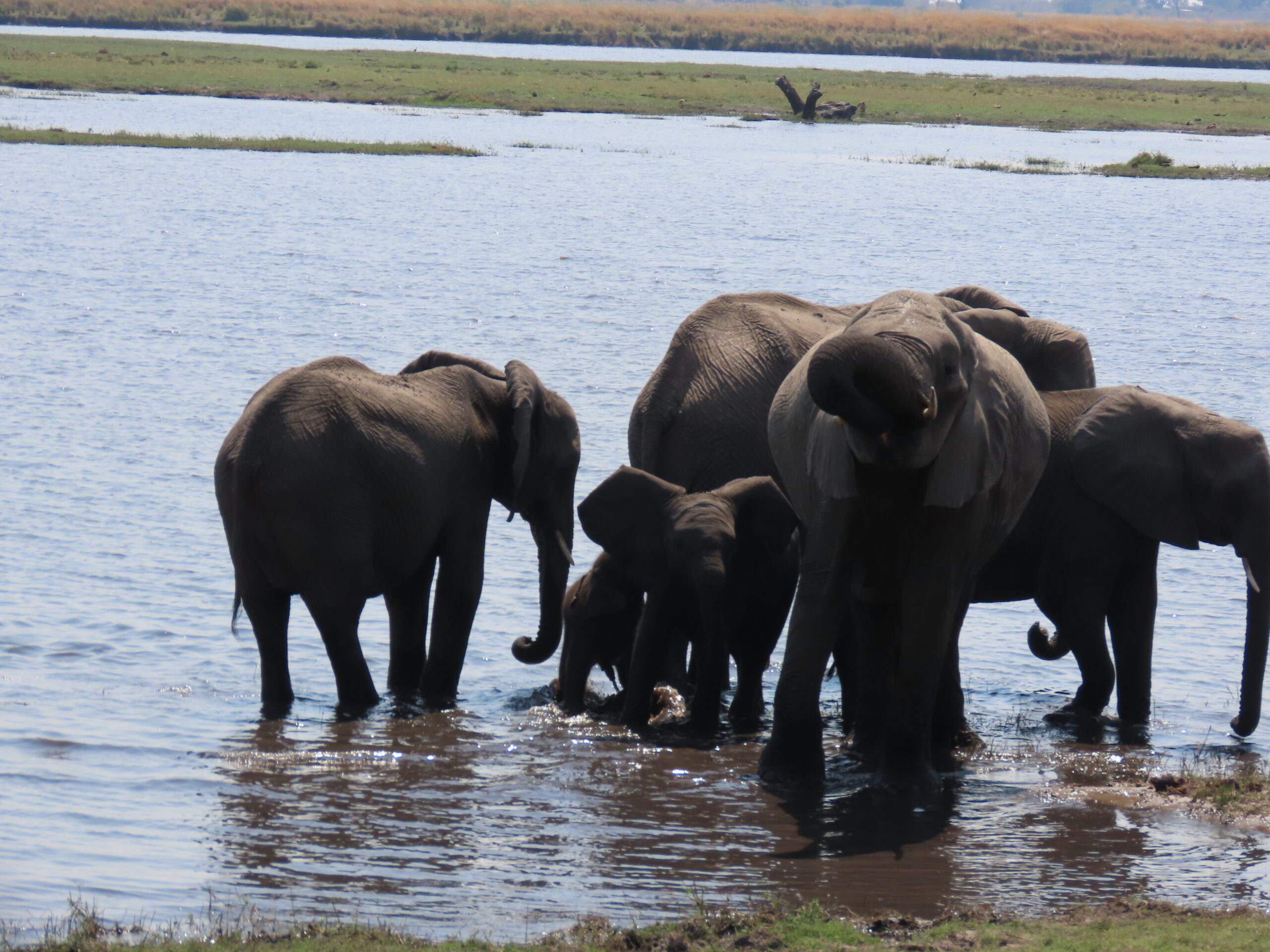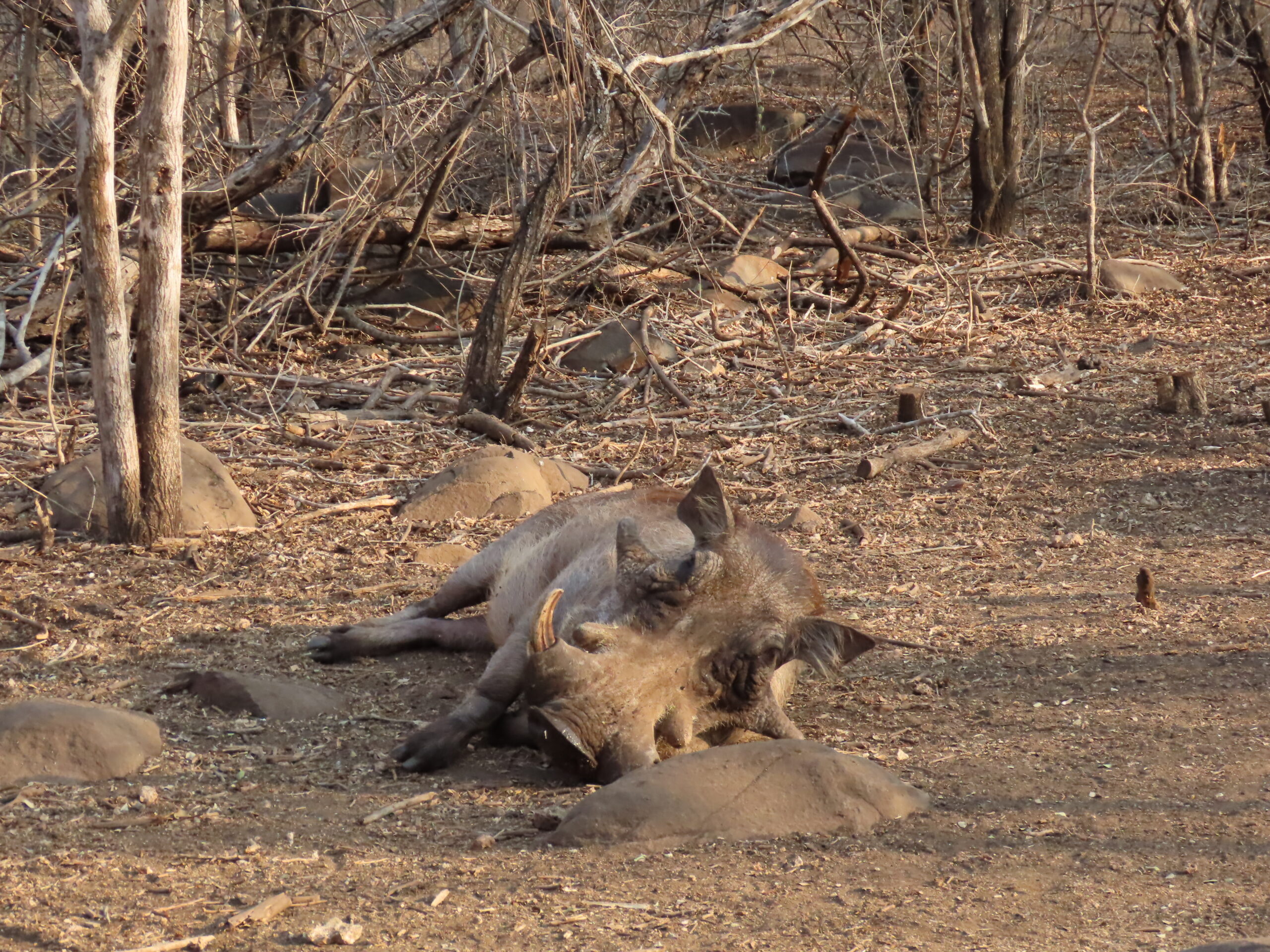
“African elephants are the largest land animals, adult males weighing between 1,800 and 6,300 kg (2 and 7 tons/ 4,000 and 14,000 lb.). Females are smaller, weighing between 2,700 and 3,600 kg (3 and 4 tons/ 6,000 and 8,000 lb.).”We never tire of seeing elephants in the wild, which is entirely different than seeing them in captivity in a zoo or, as we experienced in India, used for religious and income-producing purposes. That was heartbreaking to witness. But, here in Africa, we’ve only visited national parks where they are meant to roam…at will, in the wild. And what a joy it is to see!
We realize we’ve written many stories about elephants and elephant facts we’ve gleaned from other websites. For those who may have missed those past posts, we can’t resist sharing more of those today as we’ve posted several photos we took while on safari in Chobe National Park on Tuesday. It was a fine day with many sightings. But no game drive would be complete without elephant sightings which we’re sharing here today.

You may be bored with our endless elephant sightings or may find them fascinating. For those that don’t care to read more, we will move on to other wildlife in tomorrow’s post with some fun and quirky photos. This afternoon at 3:00 pm, 1500 hours, we will embark on a boat cruise ending after sunset from the docks here at our resort, Chobe Safari Lodge, in Kasane, Botswana.
Tomorrow at 11:30, Chris from Chris Tours, our excellent, reliable, and friendly tour organizer and transport handler, whose site may be found here. We highly recommend their services if you plan to come to Zambia, Zimbabwe, or Botswana. Recently, our readers/friends Marylin and Gary, who are now in Marloth Park, whom we hope to see one more time before they leave the first week in September, also used Chris’s services when they visited Zambia and Botswana. They, too, had an excellent experience with Chris and his associates. Contact Chris at his site here.

On another note. Enjoy these new elephant facts from this site located here:
“13 Fascinating Facts About Elephants
1. Elephants Never Forget
The memory of elephants is legendary, and for good reason. Of all land mammals, elephants possess the largest brains.2 They have the ability to recall distant watering holes, other elephants, and humans they have encountered, even after the passage of many years. Elephants transmit their wealth of knowledge from generation to generation through the matriarchs, and this sharing of information has been beneficial to the creatures’ survival. They are also able to recall the path to sources of food and water across great distances, and how to reach alternative areas should the need arise. Even more impressive, they adjust their schedule to arrive just in time for the fruit they are seeking to be ripe.

2. They Can Distinguish Languages
Elephants exhibit a deep understanding of human communication. Researchers at Amboseli National Park in Kenya played back the voices of speakers from two different groups—one that preys on the elephants, and another that does not. When the elephants heard the voices of the group they feared, they were more likely to act defensively by grouping tightly together and smelling the air to investigate. What’s more, the researchers found the elephants also responded with less intensity to female and younger male voices, becoming most agitated at the voices of adult males. Elephant language skills go beyond understanding. One Asian elephant learned to mimic words in Korean. Researchers theorize that because his primary social contact while growing up was with humans, he learned to mimic words as a form of social bonding.
3. They Can Hear Through Their Feet
Elephants have a great sense of hearing and the ability to send vocalizations over long distances. They make a variety of sounds, including snorts, roars, cries, and barks. But they also specialize in low frequency rumbles and are able to pick up sounds in an unusual way. Caitlin O’Connell-Rodwell, a biologist at Stanford University, found that the lower frequency vocalizations and foot stomping of elephants resonate at a frequency other elephants can detect through the ground. Enlarged ear bones and sensitive nerve endings in their feet and trunks allow elephants to pick up these infrasonic messages. The ability to detect such seismic vibrations also helps elephants survive. When an agitated elephant stomps, they’re not just warning those in the immediate area, they may also be warning other elephants miles away. And when an elephant rumbles a call, it could be intended for family members far out of sight.

4. Elephants Are Excellent Swimmers
It may not come as a shock that elephants enjoy playing in the water. They are famous for splashing and showering themselves and others with sprays from their trunks. But it might be a surprise to learn that these huge animals are also quite good at swimming. Elephants have enough buoyancy to stay at the surface and use their powerful legs to paddle. They also use their trunk as a snorkel when crossing deep water so they are able to breathe normally even when submerged. Swimming is a necessary skill for elephants as they cross rivers and lakes when searching for food.
5. They Support Those in Need
Elephants are highly social and intelligent creatures, and they demonstrate behaviors we humans recognize as compassion, kindness, and altruism. In a study of elephant behavior, researchers found that when an elephant became distressed, other nearby elephants responded with calls and touches intended to console the individual.7 In addition to humans, this behavior was previously only witnessed in apes, canids, and corvids. Elephants also demonstrate empathetic behavior and “targeted helping” where they coordinate with each other to help a sick or injured individual.

6. They Can Suffer From PTSD
We know that elephants are sensitive souls, with strong bonds to their family members, a need for comfort, and a long memory. So it should come as no surprise that elephants who experience tragedy, like witnessing a family member being killed by poachers, have symptoms of post-traumatic stress disorder. Calves orphaned by poachers will show PTSD-like symptoms even decades later. Elephants released from abusive situations show symptoms of PTSD long after they’ve found safety in a sanctuary. These traumatic experiences also negatively impact learning.8 When selective individuals are killed in a cull or by poachers, young elephants lose vital social information that would have been passed down by adults.

7. Elephants Need Their Elders
All of the information necessary to elephants’ survival is passed down by their elders. It’s crucial for young elephants to spend time with older family members, particularly the matriarchs, so they can learn all that they’ll need to know as adults. The matriarch of the herd carries the knowledge of the elders and shares essential information with the young including how to respond to a variety of dangers and where to find food and water. While African elephants live in a matriarchal society, research has shown that Asian elephants are less hierarchical than their African counterparts and show little dominance based on age or gender.9 This difference in social organization could be attributed to habitat. In Africa, conditions are more harsh, so the elders’ wisdom is more valuable; in parts of Asia where predators are few and resources are plentiful, there’s not as much need for strong leadership
8. They Can’t Live Without Their Trunks
Filled with over 40,000 muscles, an elephant’s trunk is powerful and extremely sensitive. Elephants use their prehensile trunks to smell, eat, breathe underwater, make sounds, clean themselves, and defend themselves. Elephants have “fingers” at the tips of their trunks—African elephants have two and Asian elephants have one—that allow them to pick up tiny objects. Extremely dexterous, elephants can form a joint with their trunk to pile up small materials like grains. An elephant will reach out its trunk and use its sense of smell to determine which foods to eat. In a 2019 study, Asian elephants were able to determine which of two sealed buckets contained more food based on smell alone.11 Another study found that African elephants could differentiate between a variety of plants and choose their favorite, guided only by scent. Elephants also use their trunks to hug, caress, and comfort other elephants—and baby elephants suck their trunks like human babies suck their thumbs. Apparently this helps them to learn how to use their trunks more effectively. With over 50,000 muscles in the trunk, this helps a young elephant figure out “how to control and manipulate the muscles in the trunk so that it can fine-tune its use.”

9. They Are Related to the Rock Hyrax
Based on sheer size alone, it’s surprising to discover that the elephant’s closest living relative is the rock hyrax, a small, furry herbivore native to Africa and the Middle East that looks similar to a rodent. Other animals closely related to elephants include manatees and dugongs (a marine mammal that looks like a manatee). Despite its appearance, the hyrax still has a few physical traits in common with elephants. These include tusks that grow from their incisor teeth (versus most mammals, which develop tusks from their canine teeth), flattened nails on the tips of their digits, and several similarities among their reproductive organs. The manatee, the rock hyrax, and the elephant share a common ancestor, Tethytheria, which died out more than 50 million years ago. That’s been long enough for the animals to travel down very different evolutionary paths. Though they look and behave differently, they remain closely related.
10. Elephants Honor Their Dead
The abundant sensitivity of elephants is well documented, but their sentient nature is particularly notable in the interest they express toward the dead. Even among unrelated animals, elephants show interest, examining, touching, and smelling the deceased animal. Researchers have observed elephants making repeated visits, attempting to assist expired animals, and calling out for help. Long after an animal has died, elephants will return and touch the remaining bones with their feet and trunks.14 The Washington Post described a young 10-year-old elephant visiting her mother’s corpse in Kenya and leaving with “the temporal glands on each side of her head… streaming liquid: a reaction linked to stress, fear and aggression.” A form of tears, perhaps?

11. They Use Dirt as Sunscreen
There’s a good reason that elephants like to play in the dirt. Although their hide looks tough, elephants have sensitive skin that can get sunburned. To counteract the damaging rays of the sun, elephants throw sand on themselves. Adult elephants will also douse youngsters with dust. When coming out of a bath in a river, elephants will often throw mud or clay on themselves as a layer of protection.15

12. They Have Math Skills
Asian elephants may just be one of the smartest creatures in the animal kingdom when it comes to math. Researchers in Japan attempted to train Asian elephants to use a computer touch screen panel. One of the three elephants, when presented with different quantities, was able to choose the panel that displayed more fruit. It should be noted that only Asian elephants have been shown to possess this ability. Researchers posit that the split of African and Asian elephant species 7.6 million years ago may have resulted in differing cognitive abilities. Some research shows that the average EQ is 2.14 for Asian elephants, and 1.67 for African.
13. Elephants Are at Risk
All elephants are at risk. The Asian elephant is endangered and the African elephant is vulnerable.1718 The primary threats to elephants are habitat loss, fragmentation, and degradation. Elephants also face human threats. As farmers encroach on elephant habitats to plant crops, conflicts between the animals and humans have led to the retaliatory killing of elephants. Asian elephants in particular, which inhabit one of the planet’s most densely populated areas, are unable to coexist with the expanding human population. There are some innovative efforts to deter elephants away from human settlements and farms, reducing friction between the two species. One example is Project Orange Elephant in Sri Lanka, which incentivizes farmers to plant orange trees around their homes and garden plots; elephants dislike citrus, and the farmers gain an additional crop to sale for profit. In spite of the 1989 international trade ban on ivory sales, the illegal and legal hunting and poaching of elephants for their tusks, hide, meat, and fur have been a large contributor to the decline of elephants, especially in Africa. Asian elephants are also poached, and since only males have tusks, this also leads to a shortage of males in the breeding population and a lack of genetic diversity.

Save the Elephants
- In an effort to eradicate poaching, don’t buy, sell, or wear any items containing ivory.
- Buy elephant-friendly fair trade coffee and Forest Stewardship Council (FSC) certified wood products.
- Adopt an elephant through the World Wildlife Foundation to support habitat protection.
- Support the International Elephant Foundation by making a donation or sponsoring an elephant.”
Thanks to the publishers of this good article and its 13 points. We appreciate these interesting facts to share with our readers along with today’s photos.
Hopefully, today on our Chobe River cruise we’ll have an opportunity to see more stunning wildlife along the banks of the river and in the water. We will be back with more tomorrow, our final day at Chobe Safari Lodge. At 11:30 am, Christ will pick us up, and we’ll head back through the border into Zambia, where we’ll spend the next two nights staying at the Marriott Protea Hotel, which we’ve visited several times.
Both nights, we’ll be going to the Royal Livingstone Hotel’s much-sought-after restaurant, The Old Drift. We would have liked to stay at that hotel, but the room cost was about 60% higher than the Marriott. After all, we’ll have spent on this trip, staying at a more expensive hotel wasn’t necessary for either of us. We’ll head back to South Africa on Saturday.
We still have one more boat cruise tomorrow night, which will be on a sunset cruise on the Zambezi River on the famous Lion King with live African music. That will be another fun outing.
We’ll be back tomorrow with more photos.
Have a great day and evening!
Photo from one year ago today, August 24, 2021:

